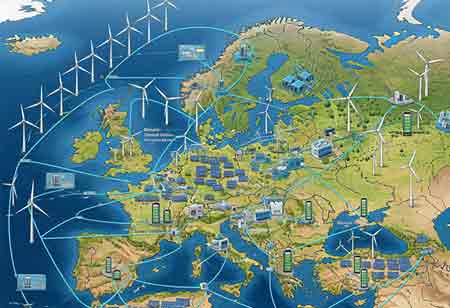Thank you for Subscribing to Energy Business Review Weekly Brief
The Rise of the Virtual Power Plant: Reinventing Energy Distribution in Europe
Europe's VPPs are redefining energy management by integrating distributed resources for enhanced grid flexibility, resilience, and support for renewable energy adoption.

By
Energy Business Review | Monday, November 10, 2025
Stay ahead of the industry with exclusive feature stories on the top companies, expert insights and the latest news delivered straight to your inbox. Subscribe today.
Fremont, CA: Europe is driven by ambitious decarbonisation targets and a rapidly expanding renewable energy sector. At the heart of this revolution lies the Virtual Power Plant (VPP), an innovative concept that is reimagining how energy is generated, distributed, and consumed. Far from a single physical entity, VPPs are intelligent networks that aggregate and manage diverse, distributed energy resources (DERs) to act as a unified power plant, offering unprecedented flexibility and stability to the grid.
The Driving Forces behind Europe's VPP Boom
Europe’s pursuit of a cleaner, more resilient energy future is a key driver behind the rapid growth of the VPP market. The demand for greater grid flexibility and stability is also rising. Traditional electricity grids were designed for centralised, predictable power generation, and the growing share of distributed renewable sources introduces operational challenges. VPPs address these issues by dynamically balancing supply and demand in real time, maintaining grid frequency, and preventing outages.
In parallel, the widespread adoption of smart grid technologies—including smart meters, IoT devices, and advanced communication infrastructure—has provided the digital foundation necessary for efficient VPP operation. These technologies enable real-time monitoring, control, and coordination of distributed energy resources (DERs), ensuring optimal performance of the aggregated network. Another transformative force is the increasing presence of electric vehicles (EVs), which are evolving into mobile energy storage assets. When integrated into VPP systems, EVs can provide grid support by adjusting their charging schedules and, in some cases, supplying stored energy back to the grid during periods of peak demand.
VPPs unlock economic opportunities and new revenue streams for DER owners. By aggregating smaller energy assets, VPPs enable them to meet the thresholds required to participate in wholesale electricity and balancing markets. This aggregation not only enhances grid reliability but also makes renewable energy and storage investments more financially appealing for both residential and commercial prosumers.
Impact on the European Energy Grid: A Paradigm Shift
The widespread adoption of VPPs is driving a significant transformation in energy distribution across Europe, offering a smarter, more resilient, and sustainable grid infrastructure. VPPs enhance grid stability and resilience by leveraging advanced algorithms to anticipate and address imbalances before they escalate. This predictive capability ensures a more reliable power supply, particularly during peak demand or unforeseen outages. The decentralised nature of VPPs further bolsters resilience, as localised disruptions are less likely to trigger broader blackouts.
In terms of resource optimisation, VPPs enable the storage of excess renewable energy—such as surplus solar or wind power—in connected battery systems, ensuring it is utilised efficiently when needed. This not only maximises the value of renewable assets but also reduces the necessity for costly grid expansions. Additionally, VPPs offer a cleaner and more cost-effective alternative to traditional peaker plants, which are typically fossil-fuel-based and expensive to operate. By dispatching stored energy or activating demand response mechanisms, VPPs help lower emissions and can reduce energy costs for consumers.
Crucially, VPPs empower consumers to become active participants—"prosumers"—within the energy ecosystem. Individuals and businesses that generate and store their energy can support grid stability and potentially benefit from financial incentives or lower utility bills. As a result, VPPs not only democratise energy participation but also accelerate Europe’s decarbonisation efforts by facilitating the seamless integration of renewables and minimising dependence on fossil-fuel generation.
VPPs are not just a technological advancement; they represent a fundamental shift in how we conceive and manage our energy systems. They are moving us away from a centralised, fossil-fuel-dependent model to a decentralised, renewable-driven, and highly responsive grid. As Europe strives to meet its ambitious climate goals and enhance its energy security, Virtual Power Plants will play an increasingly indispensable role, orchestrating a cleaner, more efficient, and more resilient energy future. The intelligent aggregation of distributed resources is truly reinventing energy distribution, paving the way for a sustainable and empowered energy landscape across the continent.






